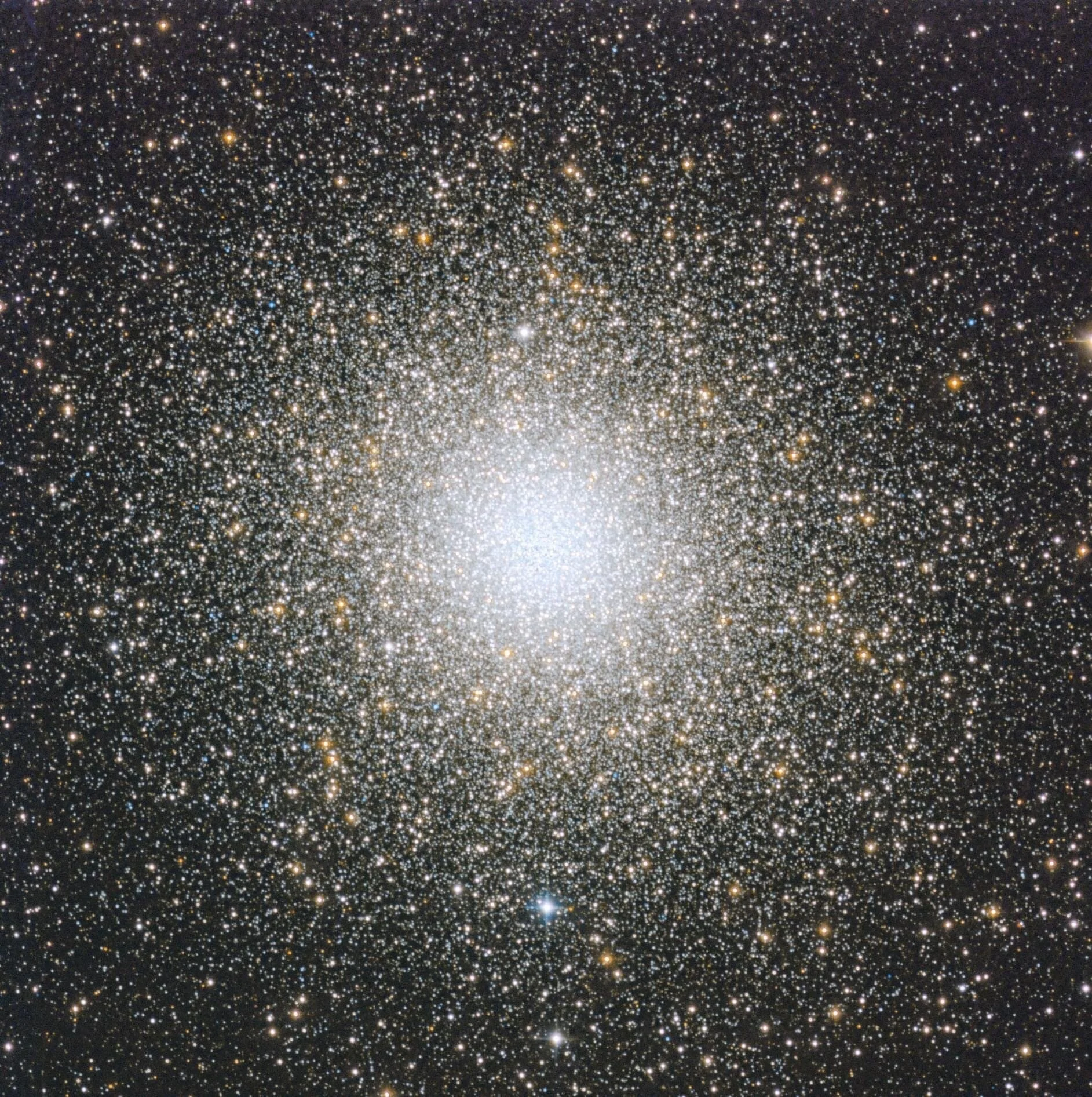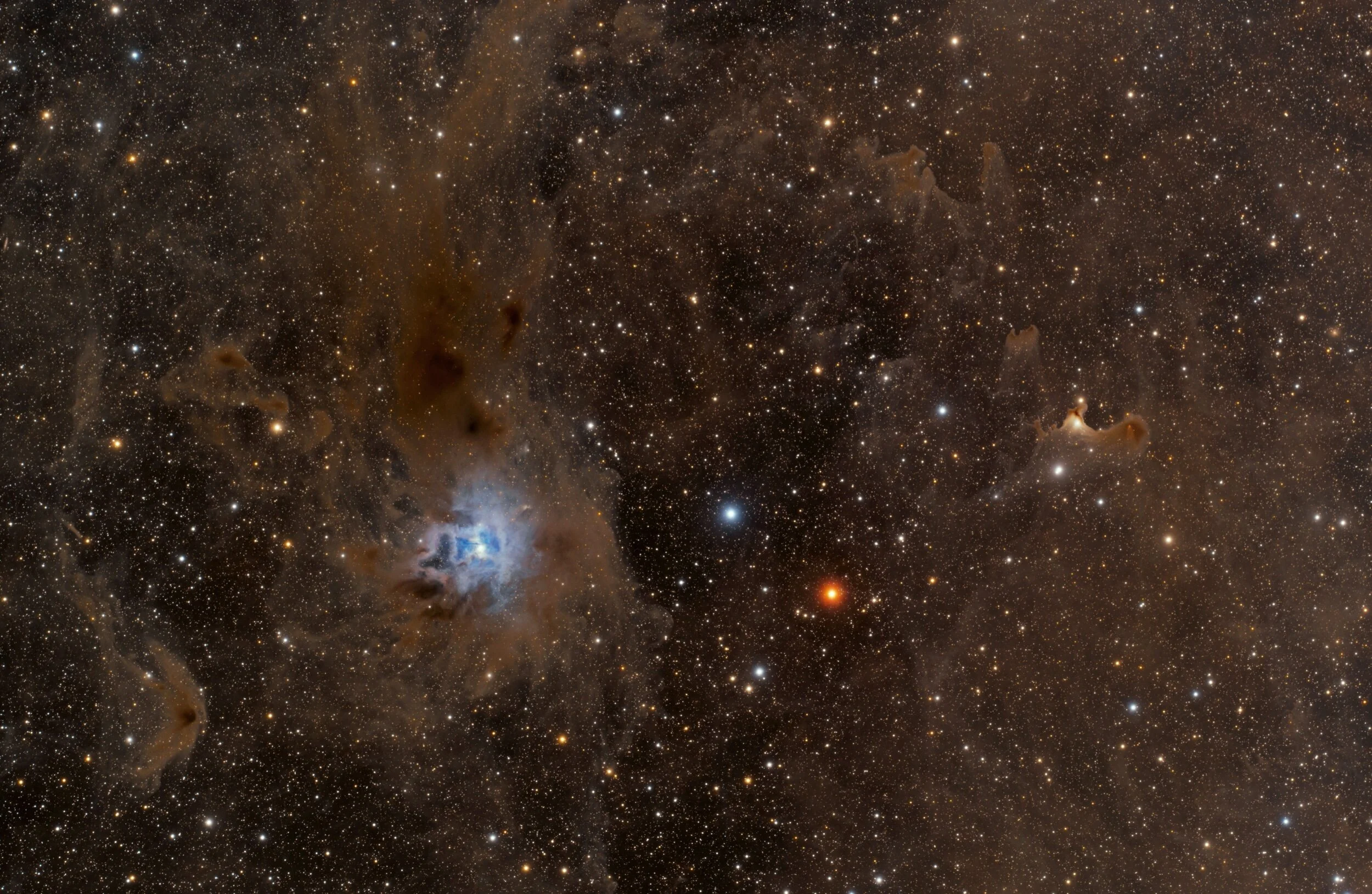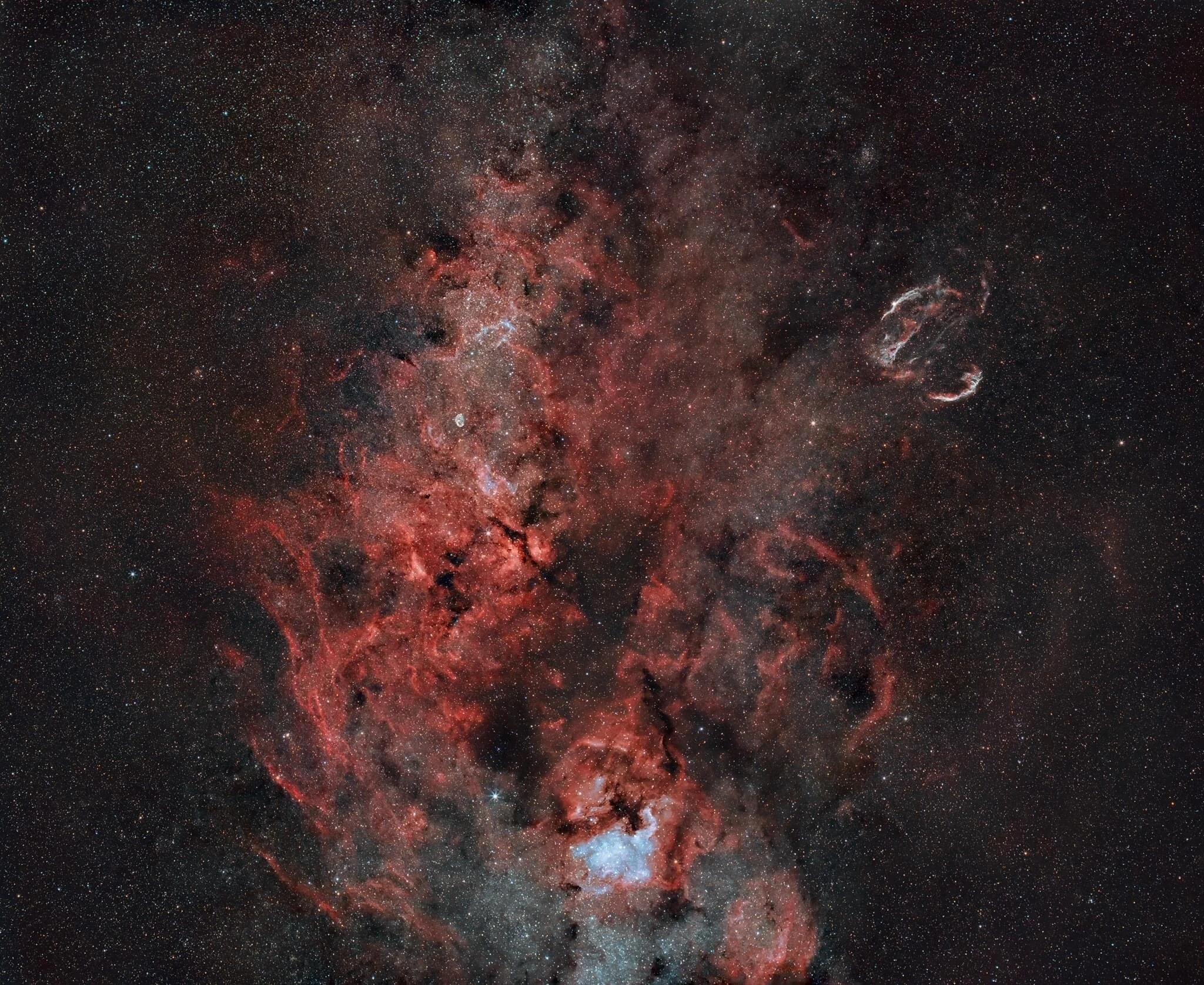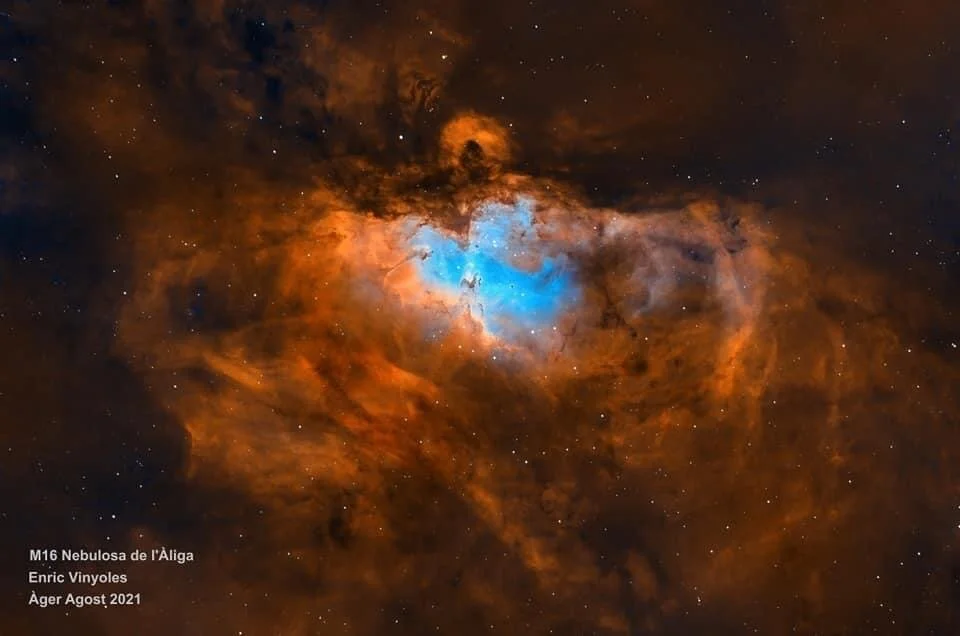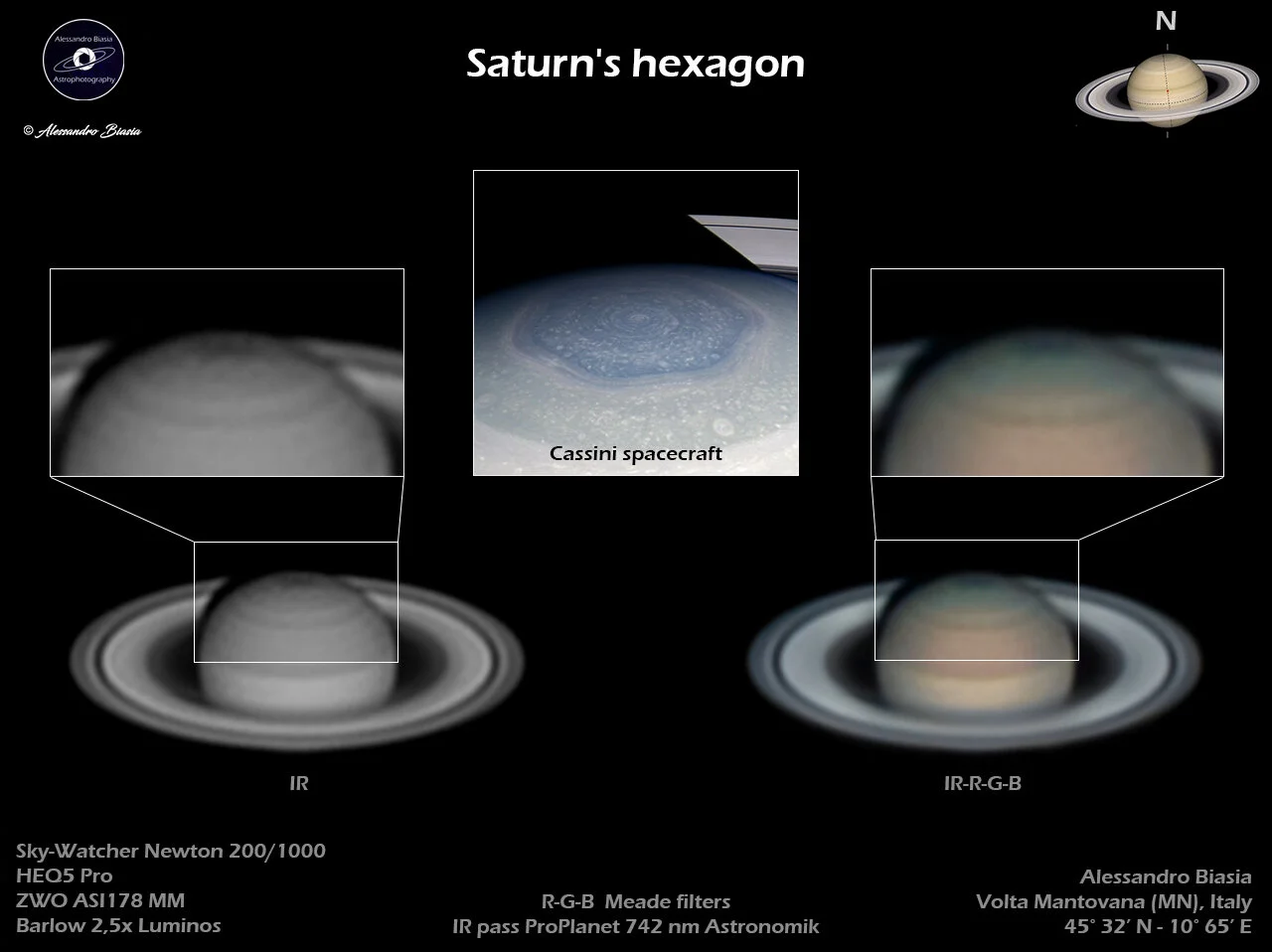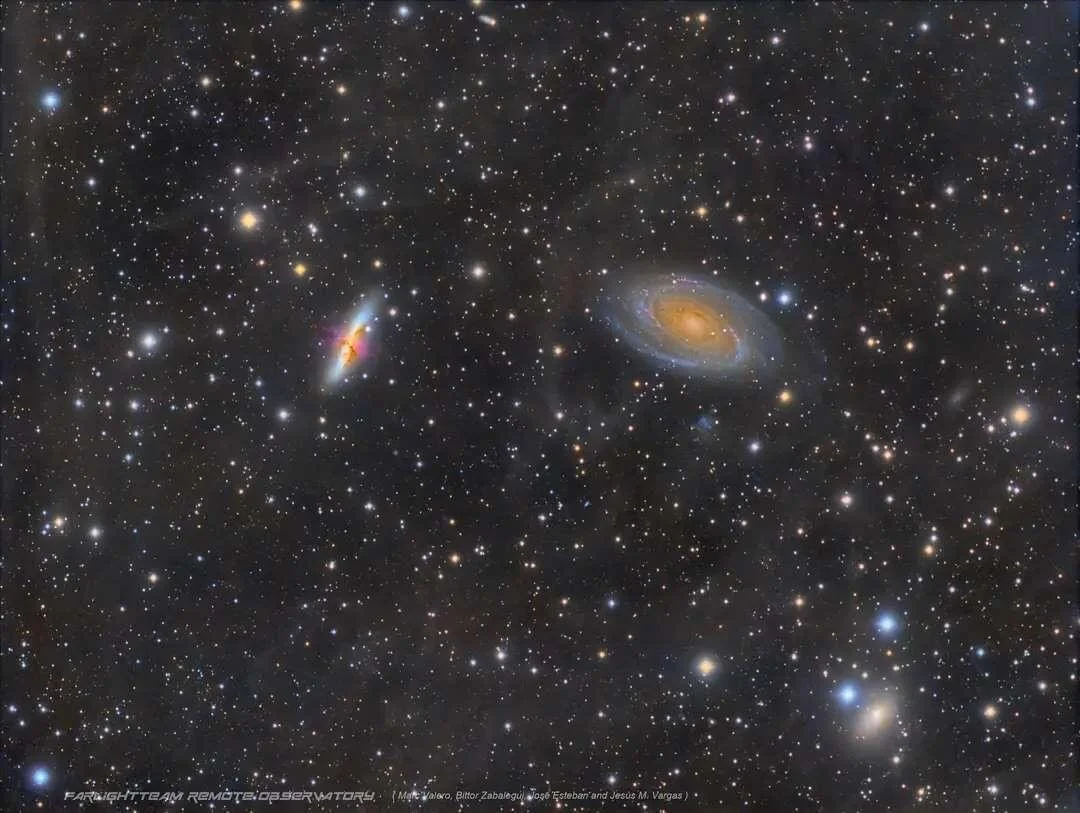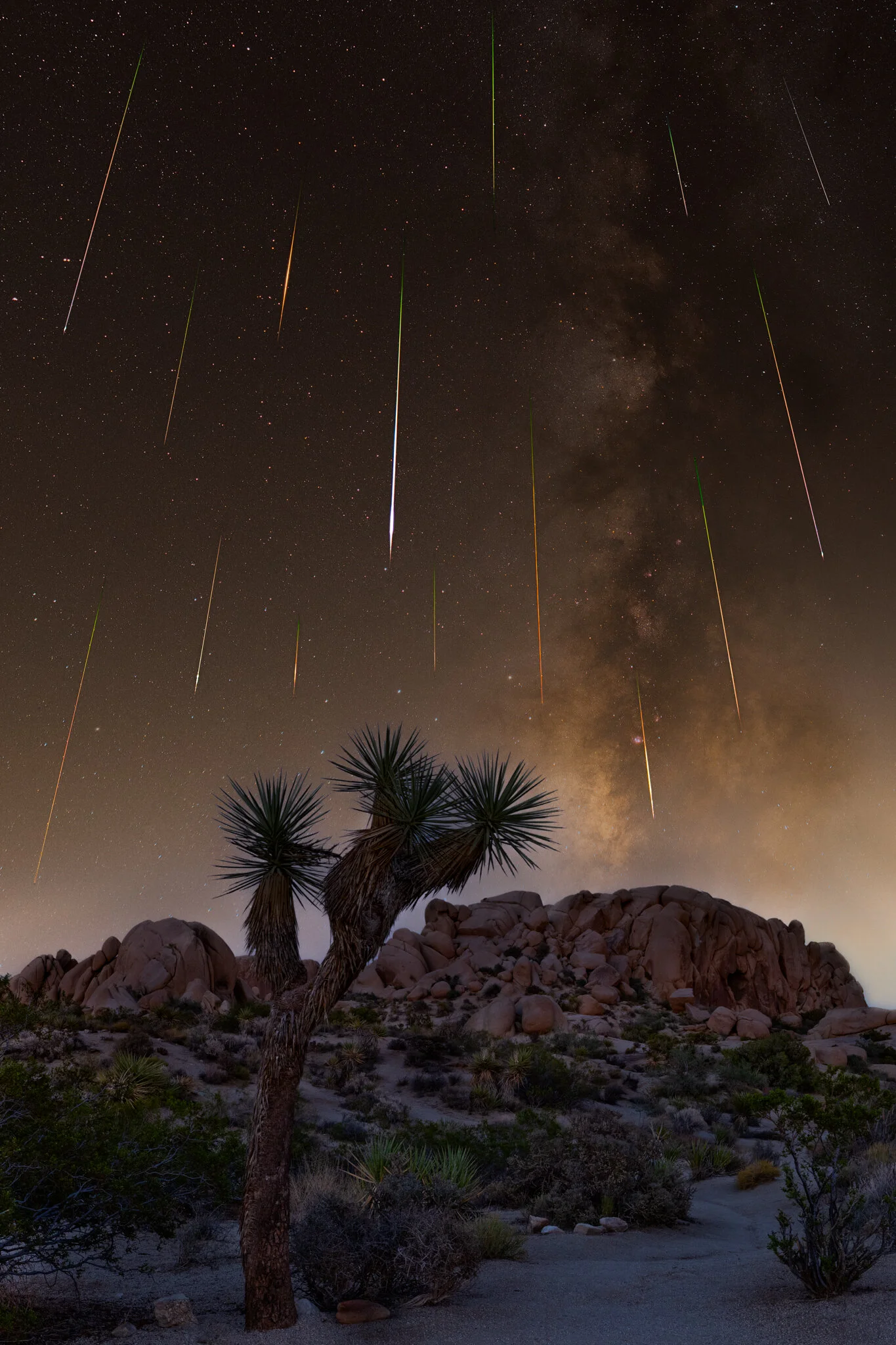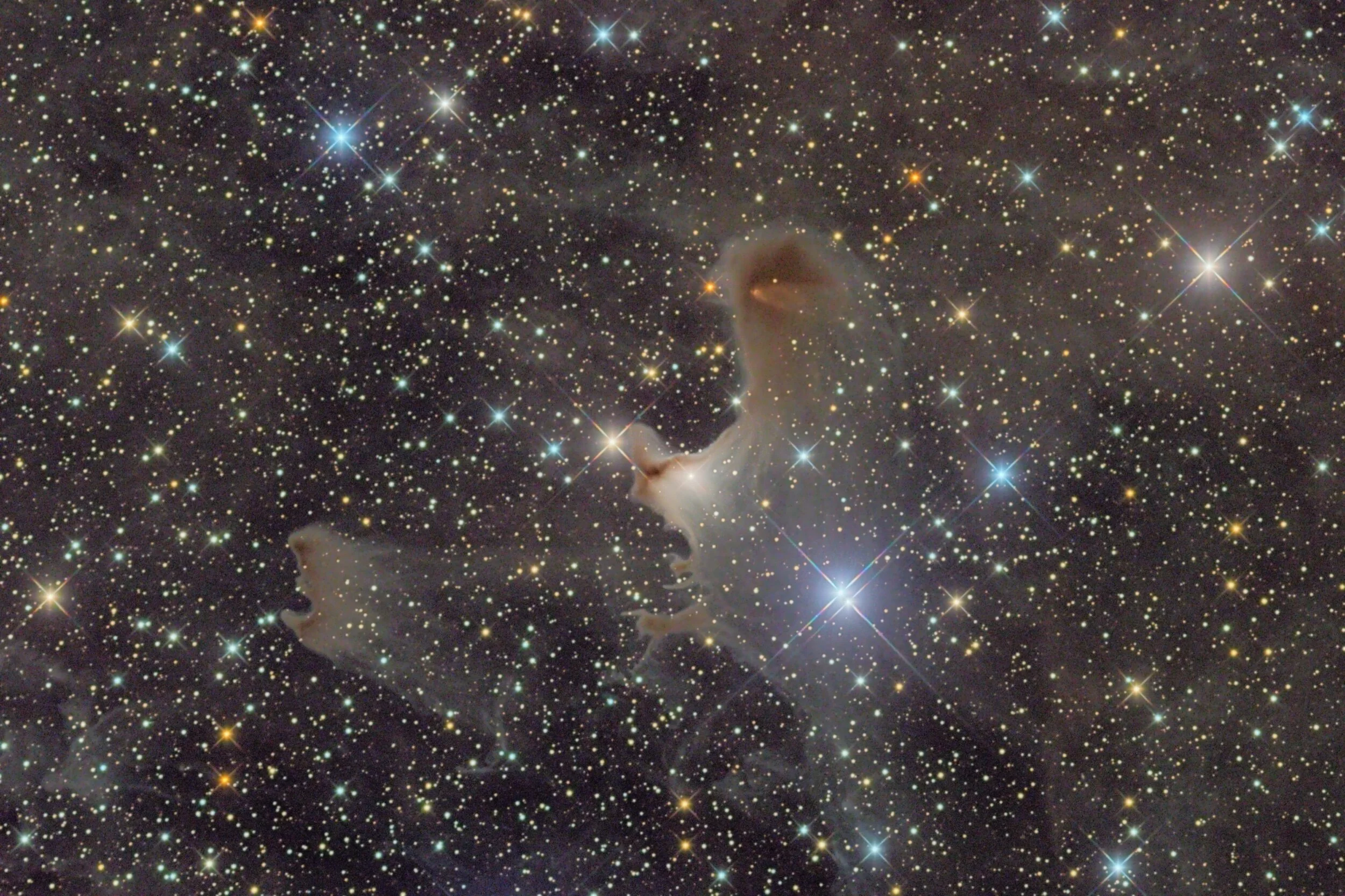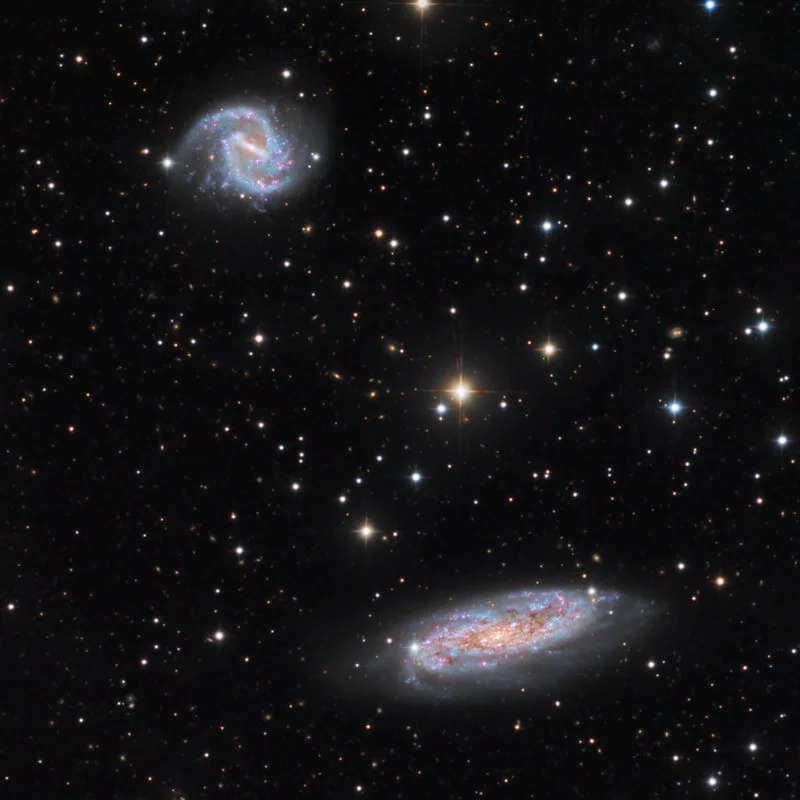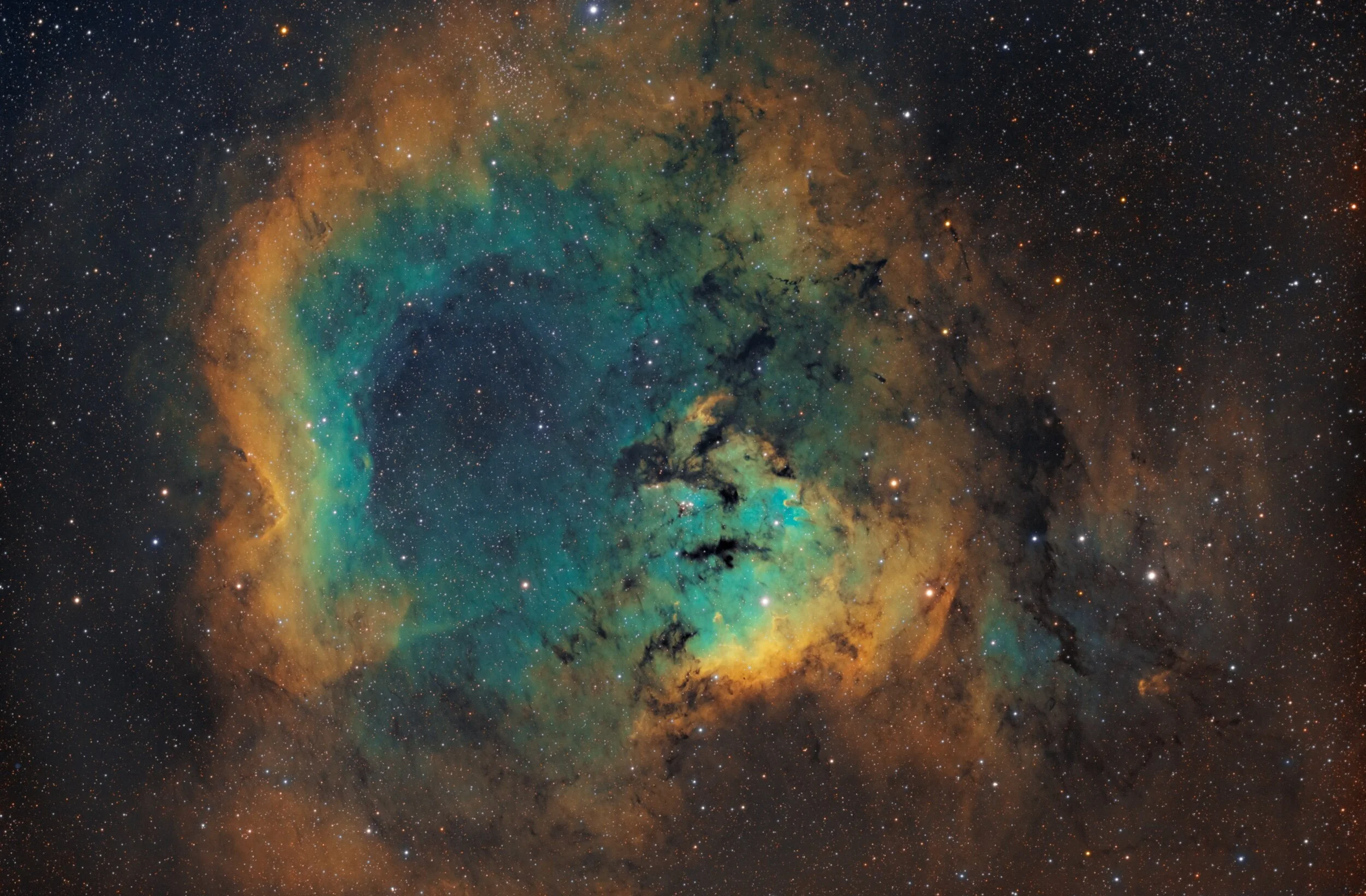
AAPOD2 Image Archives
Ngc104
Here is 47 Tucanae, AKA NGC 104 from some time I booked on a telescope in Chile. It was harder than I thought it would be to process. This is a total of 1 hour and 40 minutes of exposure after I tossed 30 minutes of L due to 300s subs absolutely destroying the core of this. I wish I had done 2x more of R, G, and B rather than the 6x L. Still, it's a really cool looking glob!
Cooyright: Scotty Bishop
Sun's photosphere. From sunspot 2859 to 2861
Image Description and Details : It seems that the sun is coming back to life.
Right now there is a rather interesting group (2860), another with a small but decent spot with some umbra (2859) and a group of 3 small spots (2861). There are also some faculae already disappearing through the limbo.
Tube: SkyWatcher ED 72/420 with a Baader Astrosolar OD 5.0 filter.
Camera: Altair GPCAM 178M
Filters: Zwo IR/UV cut and Baader Solar Continuum
Mount: SkyWatcher AZGTI over a Manfrotto 055 tripod.
Barlow: GSO x2.5 on closeups.
Acquisition: 3 videos of 180" stack on AutoStakkert2! and processed with Astro Surface OMEGA and Fitswork 4. False color from monochrome data.
Copyright: Enol M.
The Iris, the Ghost, and the Dark
Image Description and Details : Two popular long focal length targets, the Iris Nebula and the Ghost Nebula, share a field of chocolate colored dust in the constellation Cepheus. This 2 degree FOV captures both with plenty of room for the surrounding dark nebulae.
Captured over 4 nights in Goldendale Washington from Goldendale Sky Village and Sky View Acres. Both sites are Bortle 2.
Takahashi FSQ 106
QHY600M
Paramount MYT
Chroma Blue 2": 35x300" (2h 55') (gain: 56.00) -10C bin 1x1
Chroma Green 2": 32x300" (2h 40') (gain: 56.00) -10C bin 1x1
Chroma Luminance 2": 47x300" (3h 55') (gain: 56.00) -10C bin 1x1
Chroma Red 2": 31x300" (2h 35') (gain: 56.00) -10C bin 1x1
Integration: 12h 5'
Copyright:Kevin Morefield
Horsehead and a Flame
The Horsehead is one of the most famous nebulae on the sky. The horse-head feature is dark because it is really an opaque dust cloud that lies in front of the bright emission nebula. Like clouds in Earth's atmosphere, this cosmic cloud has assumed a recognizable shape by chance. After many thousands of years, the internal motions of the cloud will surely alter its appearance. The emission nebula's color is caused by electrons recombining with protons to form hydrogen atoms. On the image left is the Flame Nebula that also contains filaments of dark dust. Just to the lower left of the Horsehead nebula is a blueish reflection nebulae that preferentially reflects the blue light from nearby stars.
Tech card:
Imaging telescope: Explore Scientific 127mm ED TRIPLET APO.
Imaging camera: ZWO ASI294MM-Pro.
Mounts: iOptron CEM60.
Guiding camera: ZWO ASI290MM mini.
Focal reducer: Explore Scientific 0.7 Reducer/Flattener.
Accessory: ZWO OAG · ZWO ASIAIR Pro · ZWO 8x 1.25" Filter Wheel (EFW).
Frames:
Chroma 3nm Ha: 12x600" (2h) (gain: 200.00) -20C bin 1x1.
Chroma 3nm OIII: 15x600" (2h 30') (gain: 200.00) -20C bin 1x1.
Chroma 3nm SII: 8x600" (1h 20') (gain: 200.00) -20C bin 1x1.
Total integration: 5h 50'
Darks: ~50.
Flats: ~30.
Flat darks: ~30.
Avg. Moon age: 19.61 days.
Avg. Moon phase: 75.53%
Bortle Dark-Sky Scale: 4.00.
RA center: 5h 41' 15"
DEC center: -2° 16' 1"
Pixel scale: 0.706 arcsec/pixel.
Orientation: -93.427 degrees.
Field radius: 0.983 degrees.
Imaging dates: Jan. 3 and 4, 2021.
Imaging location: Abu Dhabi desert, UAE.
Copyright: Wissam Ayoub
Flames of Cygnus
Image Description and Details : Imaging lens: Canon 50mm USM 1.4 @ f/4
Imaging camera: ZWO ASI2600MC Pro
Mount: Sky-Watcher EQ6R-PRO
Guiding telescope: ZWO Mini Guide Scope
Guiding camera: ZWO ASI290MM Mini
Software: Aries Productions Astro Pixel Precessor, Pleiades Astrophoto PixInisight, ZWO ASIAir Pro, Photoshop CC
Filters: Optolong L-eXtreme 2", Optolong L-Pro 2'', Optolong L-eNhance 2"
Accessory: ZWO ASIAir Pro
Dates: June 20, 2020, June 21, 2020, Aug. 2, 2021, Aug. 3, 2021, Aug. 4, 2021, Aug. 5, 2021, Aug. 8, 2021, Aug. 10, 2021, Aug. 11, 2021
Frames:
Optolong L-Pro 2'': 80x90" (2h) (gain: 100.00) -5C bin 1x1
Optolong L-eNhance 2": 17x1200" (5h 40') (gain: 100.00) -5C bin 1x1
Optolong L-eNhance 2": 36x600" (6h) (gain: 100.00) -5C bin 1x1
Optolong L-eXtreme 2": 80x1200" (26h 40') (gain: 100.00) -5C bin 1x1
Integration: 40h 20'
Darks: ~40
Flats: ~40
Flat darks: ~40
Bortle Dark-Sky Scale: 8.00
Locations: Backyard, Nashville, TN, United States
Copyright: Jeffrey Horne
M16 “Eagle Nebula”
M16 from Àger, Lleida. 14 hours in total. 84 x300s Ha 40 x300s OIII 32 x300s SII 30 x60s R, G i B. TS81 telescope camera QHY183M processed at Pixinsight
Copyright: Enric Vinyoles Nicolau
WR-134
WR 134 is a Wolf-Rayet star in Cygnus which is around 6,000 light years distant. It shines at 400,000 times the luminosity of the sun. Intense radiation and stellar winds have created a bubble of gas around the star. In this image the bubble is seen in blue/green doubly ionized oxygen (OIII) light. A large amount of hydrogen (HII) emission is also displayed as the red areas. The star responsible for this is near the center of the bubble and is whiteish. The image was taken with my #Stellarvue SVX 152T refractor and #zwoasi 6200 camera through RGB and HII/OIII filters. The image combines a bit over 47 hours of exposure time. Automation was controlled with a #primalucelab Eagle 4 pro and Voyager Astrophotography Automation software. The image is cropped and rotated for a pleasing view.
COPYRIGHT: Jon Talbot
Venus
Venus images taken on August 15 and 19, 2021. A 1 micron filter has been used.
Very interesting results to be the image of august 19, showing a vertical structure from the southern region.
The false color images are shown only for aesthetic reasons.
Setup:C14 Edge HD, Fornax52 Mountain, ASI 290mono, Barlow Zeiss, IR1000nm
COPYRIGHT: Luigi Morrone
Sh2-155 “The Cave Nebula”
The Cave Nebula lies in the constellation Cepheus about 2,400 light years away, pretty close in cosmic terms. The “cave” has a bright rim ionized by the hot blue-white stars in the vicinity. The main “cave” structure is 10 light years across and is catalogued as Sharpless 155 (Sh2-155) and also as Caldwell 9 (the Caldwell catalogue was compiled by Sir Patrick Moore, and named for his mother’s maiden name). Near the lower left corner of the image is a blue reflection nebula, vdB 155. The Cave Nebula region makes a nice natural colour image, highlighting red emission nebula, blue reflection nebulae, dark nebulae and many colourful stars. I’ve also imaged the Cave Nebula before at higher resolution; that image was publishedin the April 2016 issue of Sky and Telescope.
Tekkies:
Acquisition, focusing, and control of Paramount MXmount, with TheSkyX. Focus with Optec DirectSync motor and controller. Unguided. Automation with CCDCommander. Equipment control with PrimaLuce Labs Eagle 3 Pro computer. All pre-processing and processing in PixInsight. Acquired from my SkyShed in Guelph. Average transparency and seeing. Data acquired March 2-14, 2021 in a mostly moonless sky.
Sky-Watcher Esprit 150 f/7 refractor and QHY 16200-Acamera with Optolong H-alpha, O(III) and S(II) filters
Ha: 49 x 10m = 8hr10m
O3: 47 x 10m = 7hr50m
S2: 45 x 10m = 7hr30m
Total: 23hr30m
Copyright: Ron Brecher
Orion’s Belt
The Belt of Orion or the Belt of Orion is an asterism in the constellation Orion. It contains three bright stars Alnitak, Alnilam and Mintaka.
The Orion Belt is easy to find in the night sky, as it is located on the celestial equator and is part of one of the most prominent stellar patterns in the northern sky, the hourglass-shaped constellation Orion. The asterism and constellation are visible in the northern latitudes from November to February.
This is an image made with an Epsilon 180 ed telescope, on an Atlas mount, Orion, PHP guidance system and a Canon EOS Ra camera.
Data acquisition is 120 images of 60 seconds, plus Bias, Darks and Flats.
Copyright: Cesar Cantu
SNR G 116.9 +00.1
mage Description and Details : I present to you an exotic object that was initially discovered as a planetary nebula but was requalified as a supernova afterglow that occurred over 7,500 years ago.
Located about 10,000 light years from home towards the Cassiopeia constellation, these are the filamentary remnants of a supernova that have a shell shape, part of which is doubly ionized oxygen (in blue) while the rest (in red) is essentially ionized hydrogen.
Technical details :
- Apo Takahashi FSQ 85 at F/D 5.3
- iOptron 60 cem ec mount
- Asi 2600 mm pro
- 6nm astronomik filters
- Acquisition sampling: 1.7 arcsec
- 92 x 600s HA i.e. 15 h 20 min
- 181 x 600s O3 i.e. 30 h 10 min
- 3 x 30 x 60s RGB i.e. 1 h 30 min
- Total integration: 47 h
- DOF: 31/149/25
- Date: August 2021
- Location: HAO4 observatory of Oukaimeden, Morocco.
Copyright: Aziz.K
Saturn's Hexagon
Image Description and Details :
Volta Mantovana (MN) - Italy
45°32' N - 10°65' E
05.09.2020
UTC 9:42 pm
Sky-Watcher 200/1000
HEQ5 Pro SynScan
ZWO ASI178 MM
Barlow 2,5x Luminos
IR pass ProPlanet 742 nm Astronomik
R-G-B Meade filters
Copyright: Alessandro Biasia
IC514 - The Cocoon Nebula with Lynds LDN1042 Dark Nebula, LDN1035
Imaging telescopes or lenses: TS-Optics 76EDPH
Imaging cameras: ZWO ASI2600MC Pro
Mounts: SkyWatcher AZEQ6 GT
Guiding telescopes or lenses: TS-Optics 76EDPH
Guiding cameras: ZWO ASI 224MC
Software: Adobe Inc Photoshop CC · Pleiades Astrophoto PinInsight 1.8.8-5 (64)
Filters: Optlong L-eXtreme 2" · Hutech NGS1 2''
Dates:Aug. 12, 2021 , Aug. 14, 2021
Frames:
Hutech NGS1 2'': 100x180" (5h) (gain: 100.00) -10C
Optlong L-eXtreme 2": 33x300" (2h 45') (gain: 100.00) -15C
Integration: 7h 45'
Avg. Moon age: 5.09 days
Avg. Moon phase: 27.20%
Temperature: 10.00
Copyright: Arnaud Couillard
M81 & M82
Well, a first version has already been made with the IFN (Integrated Flux Nebula) processing, clouds of cosmic dust located between the galaxies, specifically this is intergalactic dust that in the background give a somewhat dirty appearance to the image, but they are that, cosmic dust from space, composed of particles smaller than 100 µm.
OBSERVATORY REMOTE FARLIGHTTEAM:
Takahashi FSQ-106 f/5 530mm
CCD QSI 683ws8
Mount 10 Micron 1000
Rotator Pegasus-MGPBox-PowerBox-Armadillo Focuser - Lunatic Zerodew
Voyager software - MountWizar - PixInsight - Adobe PS
Luminance 90 shots of 900 (22`5 hours)
Halfa 56 shots of 900 (14 hours)
Halfa 16 takes of 1200 (5 and a half hours)
RGB 12 shots for each 600 channel (2 hours for each channel in RGB)
Total 48 hours of lights
Darks 60 x900 "+ 60x1200" + 60x600 "
Bias 202
Flats 60xL + 60xHa + 60xR + 60xG + 60xB
Copyright: Jesus Vargas, Marc Valero, Bittor Zabalegui, and José Esteban
Celestial Fireworks
Image Description and Details : Perseids Meteor Shower is probably the most beautiful of all, because of the Milky Way aligning in south-west direction during this time of the year. This is exactly opposite to the radiant point of these meteors (Perseus Constellation) which is in the north-east sky, and hence the opportunity to see meteors flying over the Milky Way's galactic center! This is a stack of images collected over the nights of August 11th and 12th at Joshua Tree National Park. The lone Joshua Tree in front of the park's Jumbo Rocks area gave me a gorgeous foreground, thanks to Google Maps and an hour of scouting. Although my camera captured only 14 meteors along with a huge Fireball, we could see many more meteors outside the lens' field of view with our naked eyes and every single meteor had people shouting in joy.
The past few months and years have clearly shown the devastating effects of climate change and to add to the long list of consequences, the California wildfires from Climate Change also meant smoky skies for most of the northern part. Clear skies may not be on top of the priority list, but this would mean we can no longer preserve the natural beauty of night sky, thereby affecting the millions of animals and plants that need clear skies to survive at night. It's imperative that we all act immediately with small steps and preserve what nature has created for us having endured a multitude of external factors. Dedicating this post to the brave firefighters @calfire who have been battling to contain one of the biggest wildfires in recent history.
EXIF:
Foreground: Shot under blue-hour, Nikon D850, Sigma 20 mm f1.4 @f9, ISO 400, 60 secs exposure.
Sky: Tracked Milky Way shot at f1.8, ISO 800, 60 seconds exposure
Meteors: Timelapse shots at f1.8, ISO 800, 10 seconds exposure
Copyright: Arjun Raju
vdB141 - The ghost Nebula in Cepheus
Image Description and Details : Telescope: Artec250 Newtonian f/4 Astrograph
Imaging camera: QSI683 @-30°C
Guiding camera: Lodestar
Corrector: Televue Paracorr 2''
Mount: iOptron CEM120 EC
Acquisition software: Voyager
Astrodon Gen2 filter set
L =27x900s (bin1)
R = 8x1200s (bin1)
G = 9x1200s (bin1)
B = 9x1200s (bin1)
Processed in PixInsight 1.8
Copyright: Flavio Simeone
NGC 3511
Image description
Ngc3511 is an intermediate spiral galaxy located 45,000,000 light-years away in the southern constellation of Crater. Appearing at lower-right, it was discovered in 1786 by William Herschel, and is about 70,000 light-years across. At upper-left is the face-on SBc spiral, NGC 3513, gravitationally related to 3511.
Many thanks to my collaborator and friend, Mike Selby, who acquired and calibrated this fine data from Observatorio El Sauce, Chile. I dedicate this image to fellow astrophotographer and friend, Rogelio Bernal Andreo, on the passing of his beloved wife, Ariana. May she go among the imperishable stars!
Copyright: Warren Keller
NGC7822 SHO
Image Description and Details :
NGC 7822 is a young star forming complex in the constellation of Cepheus. The complex encompasses the emission region designated Sharpless 171, and the young cluster of stars named Berkeley 59. The complex is believed to be some 800–1000 pc distant, with the younger components aged no more than a few million years. The complex also includes one of the hottest stars discovered within 1 kpc of the Sun, namely BD+66 1673, which is an eclipsing binary system consisting of an O5V that exhibits a surface temperature of nearly 45,000 K and a luminosity about 100,000 times that of the Sun. The star is one of the primary sources illuminating the nebula and shaping the complex's famed pillars of creation-type formations, the elephant trunks.
Détails acquisitions :
HA 105 x 300s
O3 60 x 300s
S2 63 x 300s
soit 19H total
ave la lunette askar400 + red
camera asi264MM
monture ioptron CEM120
Traitement Pixinsight et Photoshop
Copyright: Lamagat Frédéric
Perseids over a 17th century monastery
Image Description and Details :
The image is of the Hanle Monastery under Bortle 1 skies and the Perseids. Hanle monastery is a 17th century gompa of the Drupka lineage of the kagyu school of Tibetan Buddhism located in the Hanle valley of Leh District, Ladakh, India. Hanle lies at an altitude of about 14500ft and is also home to the Indian Astronomical Observatory . The location of the monastery and the observatory is highly sensitive due to its proximity to the disputed Chinese border and access is restricted to a very few. Image was taken on the nights of 10 and 11-Aug-21. A blue hour foreground was first shot and then when the quadrant rose, 20 images of the night sky were stacked with the meteors blended in.
Copyright: Vikas Chander and Dorje Angchuk



